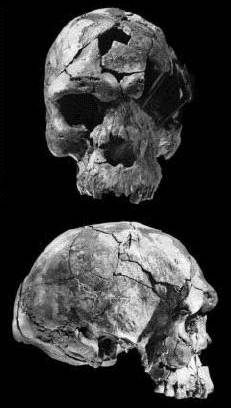Copyright © Jim Foley || Email me

 Some new fossils from Herto in Ethiopia, are the oldest known modern
human fossils, at 160,000 yrs. The
discoverers have assigned them to a new subspecies, Homo sapiens
idaltu, and say that they are anatomically and chronologically intermediate
between older archaic humans and more recent fully modern humans. Their
age and anatomy is cited as strong evidence for the emergence of modern
humans from Africa, and against the multiregional theory which argues that
modern humans evolved in many places around the world.
Some new fossils from Herto in Ethiopia, are the oldest known modern
human fossils, at 160,000 yrs. The
discoverers have assigned them to a new subspecies, Homo sapiens
idaltu, and say that they are anatomically and chronologically intermediate
between older archaic humans and more recent fully modern humans. Their
age and anatomy is cited as strong evidence for the emergence of modern
humans from Africa, and against the multiregional theory which argues that
modern humans evolved in many places around the world.
Three skulls were found:
"Because the Herto hominids are morphologically just beyond the range of variation seen in AMHS [anatomically modern Homo sapiens], and because they differ from all other known fossil hominids, we recognize them here as Homo sapiens idaltu, a new palaeosubspecies of Homo sapiens".Stringer (2003), however, in a commentary article, suggests that the skulls may not be distinctive enough to warrant a new subspecies name.
Both anatomically and chronologically, the Herto skulls seem intermediate between earlier and more primitive skulls such as Bodo and Kabwe ('Homo rhodesiensis') and the first completely modern human skulls which are first found from about 115,000 years ago.
The authors' final conclusion is that "When considered with the evidence from other sites, this shows that modern human morphology emerged in Africa long before the Neanderthals vanished from Eurasia." Because of this, these finds have been generally seen as a setback for the Multiregional model of human evolution (which argues that modern humans evolved in geographically widespread areas of the world) and strong support for the competing Out Of Africa model (which argues that modern humans evolved in Africa and spread out from there, displacing any preexisting populations).
Clark J.D., Beyene Y., WoldeGabriel G., Hart W., Renne P., Gilbert H. et al. (2003): Stratigraphic, chronological and behavioural contexts of Pleistocene Homo sapiens from Middle Awash, Ethiopia. Nature, 423:747-52.
Stringer C.B. (2003): Out of Ethiopia. Nature, 423:692-4.
White T.D., Asfaw B., DeGusta D., Gilbert H., Richards G.D., Suwa G. et al. (2003): Pleistocene Homo sapiens from Middle Awash, Ethiopia. Nature, 423:742-7.
Oldest human skulls found (Jonathan Amos, BBC)
Odd skulls from oldest modern humans (Richard Stenger, CNN)
This page is part of the Fossil Hominids FAQ at the talk.origins Archive.
Home Page |
Species |
Fossils |
Creationism |
Reading |
References
Illustrations |
What's New |
Feedback |
Search |
Links |
Fiction
http://www.talkorigins.org/faqs/homs/herto.html, 12/02/2014
Copyright © Jim Foley
|| Email me 